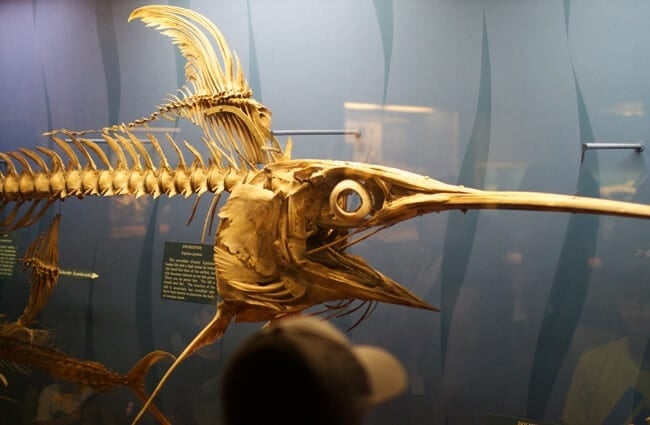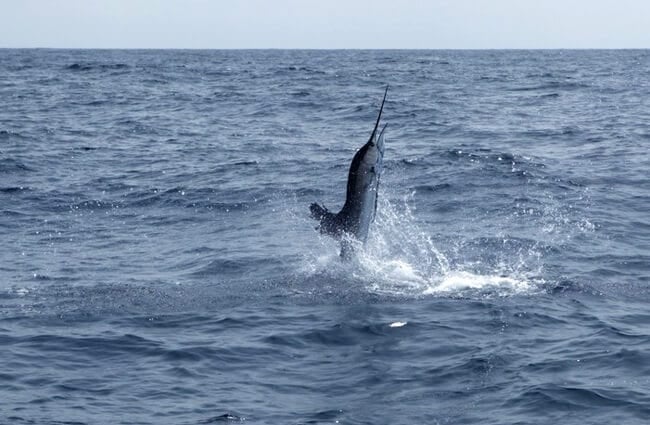Deep beneath the waves, where sunlight fades into an ethereal twilight, roams a creature of mythic proportions and incredible power: the swordfish. With its distinctive, elongated bill and formidable presence, this oceanic marvel has captivated human imagination for centuries. From ancient mariners to modern scientists, the swordfish, known scientifically as Xiphias gladius, stands as a testament to evolution’s ingenuity, a true gladiator of the global seas.
The Ocean’s Gladiator: An Introduction to the Swordfish
Imagine a fish that can slice through water with the grace of a ballet dancer and the speed of a torpedo. That is the swordfish. Instantly recognizable by its long, flattened, sword-like bill, this pelagic predator is a solitary wanderer of the world’s oceans. Unlike many other large marine species, the swordfish is a truly cosmopolitan creature, found in tropical, subtropical, and temperate waters across the Atlantic, Pacific, and Indian Oceans. Its presence signifies healthy, productive marine ecosystems, making it a vital indicator of ocean well-being.

Anatomy of a Hunter: What Makes a Swordfish Unique?
The swordfish is built for speed and efficiency. Adults can reach impressive sizes, commonly exceeding 10 feet in length and weighing hundreds of pounds, with some giants pushing past 14 feet and over 1,400 pounds. Their bodies are sleek and streamlined, tapering towards a powerful, crescent-shaped caudal fin, or tail, which propels them through the water at astonishing velocities. Young swordfish possess scales, but these are shed as they mature, leaving adults with smooth skin. They also have a unique dorsal fin that is tall and rigid in juveniles but becomes smaller and more separated into two distinct fins in adults.
The Mighty Rostrum: More Than Just a Weapon
The most striking feature, of course, is the “sword” itself. This isn’t a tooth or a horn, but an extension of the upper jaw and nasal bones, known as a rostrum. Unlike the rounded, spear-like bills of marlins, the swordfish’s rostrum is distinctly flattened and broad. Its primary function is not to spear prey, as often depicted in popular culture, but rather to slash and stun. A swordfish will charge into schools of fish, swinging its head from side to side, incapacitating multiple prey items before circling back to consume them. This highly effective hunting strategy allows it to tackle a wide variety of fast-moving prey.
Beyond its hunting prowess, the swordfish possesses another remarkable anatomical adaptation: specialized “brain heaters” or “eye heaters.” These unique organs, located near their eyes, warm their eyes and brain. This allows them to maintain optimal vision and neurological function when diving into the frigid depths in pursuit of prey, giving them a significant advantage over cold-blooded competitors in deep, dark waters.

Deep Sea Dwellers: Habitat and Migration
Swordfish are truly creatures of the open ocean, preferring the vast expanses of the pelagic zone rather than coastal waters. They thrive in a wide range of temperatures, from warm tropical seas to cooler temperate zones, typically between 50 and 80 degrees Fahrenheit. Their incredible adaptability allows them to inhabit depths ranging from the surface down to over 1,800 feet, often making daily vertical migrations. They ascend to shallower waters at night to feed on schooling fish and squid, then retreat to deeper, cooler waters during the day.
These magnificent fish are also renowned for their extensive migrations. Driven by feeding opportunities and reproductive urges, swordfish undertake epic journeys across entire ocean basins. They often move towards cooler, more productive feeding grounds in summer and return to warmer waters for spawning during winter. These migrations highlight their resilience and their critical role in connecting diverse marine ecosystems.

A Predator’s Plate: What Do Swordfish Eat?
As apex predators, swordfish are opportunistic hunters with a diverse diet. Their menu largely depends on their location and the availability of prey. They are primarily piscivores, meaning fish eaters, but they also consume a significant amount of cephalopods. Common prey items include:
Their hunting strategy, involving the stunning slash of their sword, allows them to efficiently target and consume both schooling fish and solitary, larger prey. The eye heaters are particularly crucial for deep-water hunting, enabling them to spot prey in low-light conditions.
Life’s Journey: Reproduction and Growth
The life cycle of a swordfish begins in warm, tropical, or subtropical waters, which serve as their primary spawning grounds. Females release millions of eggs into the open ocean, where fertilization occurs externally. The eggs are buoyant and drift with the currents, developing into tiny larvae. These larvae are equipped with a short, pointed bill, which gradually elongates into the characteristic sword as they grow.
Swordfish exhibit rapid growth rates, especially in their juvenile stages. They reach sexual maturity relatively quickly, typically around 3 to 6 years of age, depending on their sex and environmental conditions. Females generally mature later and grow larger than males. While their exact lifespan can vary, swordfish are thought to live for up to 9 years for males and up to 15 years for females, though some individuals may live longer.
Evolutionary Echoes: The Swordfish’s Ancestry
The swordfish belongs to the family Xiphiidae, a distinct lineage within the order Istiophoriformes, which also includes marlins and sailfish. Fossil records indicate that billfish have a long and fascinating evolutionary history, with ancestors dating back tens of millions of years. The unique flattened sword of Xiphias gladius distinguishes it from other billfish, which typically have rounder, more spear-like bills. This specialized rostrum is a testament to millions of years of adaptation, finely tuned for its particular hunting style and ecological niche. Studying their evolution helps scientists understand how these magnificent predators have adapted to changing ocean conditions over geological timescales.
Guardians of the Deep: Ecosystem Role and Interactions
As an apex predator, the swordfish plays a crucial role in maintaining the health and balance of marine ecosystems. By preying on a wide variety of fish and cephalopods, they help regulate populations of their prey species, preventing overgrazing and promoting biodiversity. Their extensive migrations also facilitate the transfer of energy and nutrients across vast oceanic regions. While swordfish are formidable hunters, they are not without their own predators, especially when young. Larger sharks, such as mako and great white sharks, and even killer whales, may occasionally prey on adult swordfish, though such encounters are rare due to the swordfish’s speed and defensive capabilities.
Swordfish and Humanity: A Complex Relationship
For centuries, swordfish have been a prized catch for humans, both for sustenance and sport. Their firm, flavorful meat is highly sought after, making them a significant target for commercial fisheries worldwide. Traditional methods often involved harpooning, while modern commercial fishing primarily uses longlines, which can stretch for miles with thousands of baited hooks. Sport fishing for swordfish is also popular, attracting anglers seeking the thrill of battling such a powerful and elusive fish.
However, this intense interest has led to conservation concerns. Overfishing in some regions has impacted swordfish populations, prompting international efforts to manage fisheries and implement quotas. Bycatch, the unintentional capture of non-target species like sea turtles and sharks, is another challenge associated with longline fishing. Organizations and governments are working on more sustainable fishing practices and gear modifications to reduce these impacts. Culturally, the swordfish has inspired literature, most famously Ernest Hemingway’s “The Old Man and the Sea,” where it symbolizes strength, perseverance, and the raw power of nature.

Encountering a Swordfish in the Wild: A Rare Privilege
For the animal lover or aspiring zoologist hoping to observe a swordfish in its natural habitat, it is important to understand that these are open-ocean, deep-diving creatures. Direct encounters are rare and typically occur far offshore. To increase your chances of seeing one, you would need to be in areas known for swordfish activity, such as productive fishing grounds in the Atlantic, Pacific, or Indian Oceans, often hundreds of miles from shore. This usually involves being on a specialized fishing charter or research vessel. Observing them from a distance, perhaps breaching the surface, is the most likely scenario. If you are fortunate enough to encounter a swordfish, whether from a boat or, in the extremely rare event of one washing ashore, always:
- Observe from a distance: Respect its wild nature and power. Do not attempt to touch or interact with it.
- Do not approach closely: Even a stranded or injured swordfish can be dangerous due to its size and sword.
- Contact local authorities: If a swordfish is stranded or appears distressed on a beach, immediately contact your local marine mammal stranding network, wildlife authorities, or coast guard. They are equipped to handle such situations safely and humanely. A hiker encountering a swordfish on land is virtually impossible unless the fish has washed ashore, in which case the above advice applies.
- Minimize disturbance: Avoid making loud noises or sudden movements that could further stress the animal.
The Challenges of Captivity: Why Swordfish Aren’t Zookeepers’ Regulars
While many marine species thrive in aquariums, the swordfish presents immense challenges for captive care, making it an exceptionally rare sight in zoological facilities. Their specific needs are simply too vast and complex for even the largest public aquariums to accommodate long-term. If a zookeeper were hypothetically tasked with caring for a swordfish, the following considerations would be paramount, highlighting why it is generally avoided:
- Immense Space Requirements: Swordfish are large, fast, and highly migratory. They require vast, open ocean spaces to thrive. A captive environment would need an enclosure of unprecedented scale, far larger than typical aquarium tanks, to allow for their natural swimming patterns and to prevent stress-induced injuries from colliding with tank walls.
- Specialized Diet: Replicating their diverse diet of live, fast-moving fish and cephalopods in sufficient quantities would be a logistical and financial challenge. They are active hunters, and providing adequate stimulation and nutrition would be difficult.
- Water Quality and Environment: Maintaining pristine, open-ocean water quality, temperature, and currents in a massive tank would require highly advanced and expensive life support systems.
- Stress and Injury: Swordfish are prone to stress in confined spaces, which can lead to rapid decline in health, injuries from bumping into tank walls, and disorientation. Their speed and powerful movements make them particularly vulnerable to self-inflicted harm in an enclosed environment.
- Ethical Considerations: Given their migratory nature and specialized needs, the ethical implications of keeping such a species in captivity are significant. Most zoological institutions prioritize the welfare of their animals, and for swordfish, this usually means leaving them in their natural, boundless habitat.
Therefore, zookeepers do not typically care for swordfish. The focus for these magnificent creatures remains on conservation in the wild.
Fascinating Facts: Unsheathing More Swordfish Secrets
The swordfish is full of surprises. Here are a few more intriguing facts:
- Fastest Swimmers: While exact speeds are debated, swordfish are among the fastest fish in the ocean, capable of bursts exceeding 60 miles per hour.
- Warm-Blooded Eyes: Their unique eye heaters make them one of the few fish species capable of warming specific parts of their body, a trait usually associated with mammals and birds.
- No Pelvic Fins: Adult swordfish lack pelvic fins, a feature that further streamlines their bodies for speed.
- Solitary Hunters: Unlike many schooling fish, swordfish are generally solitary, coming together primarily for spawning.
- Deep Divers: They can dive to depths of over 1,800 feet, enduring immense pressure and cold temperatures thanks to their physiological adaptations.
- Sexual Dimorphism: Female swordfish grow larger and live longer than males.
- Ancient Lineage: Their evolutionary history stretches back millions of years, making them a truly ancient and successful lineage of marine predators.
The swordfish is more than just a powerful predator; it is a symbol of the ocean’s wild beauty and complexity. Understanding and appreciating these magnificent creatures is the first step towards ensuring their continued survival in our ever-changing world. By supporting sustainable fishing practices and advocating for healthy ocean ecosystems, we can help protect the future of the ocean’s gladiator for generations to come.

![Red Angus Closeup of a beautiful Red Angus cowPhoto by: U.S. Department of Agriculture [pubic domain]https://creativecommons.org/licenses/by/2.0/](https://animals.net/wp-content/uploads/2020/03/Red-Angus-4-238x178.jpg)




![Red Angus Closeup of a beautiful Red Angus cowPhoto by: U.S. Department of Agriculture [pubic domain]https://creativecommons.org/licenses/by/2.0/](https://animals.net/wp-content/uploads/2020/03/Red-Angus-4-100x75.jpg)

